

Top dividend payers under scrutiny in turbulent market
Brenda Nicholls of Mackenzie Investments says discerning dividend investors seek stable earners in high-rate environment
- Featuring: Brenda Nicholls
- September 12, 2023 September 12, 2023
- 13:01
- From: Mackenzie Investments

(Runtime: 5:00. Read the audio transcript.)
**
Well-run companies with visionary leadership and growing yield are the dividend equities to watch in an unsettled market, says Brenda Nicholls, assistant vice-president and portfolio manager with Mackenzie Investments.
Nicholls said 2023 has been a mixed year for dividend equities so far, but innovative companies with good fundamentals are best positioned for the long run.
“The high-quality, innovative, profitable growers that provide a solid balance between paying dividends and investing in growth opportunities — we believe these equities will be the market winners in the years ahead,” she said. “These are the companies that can form a solid core component to anyone’s overall portfolio.”
And while everyone’s looking for high yield, she cautions investors to be leery of inordinately high payouts.
“We have research that definitively shows that from the middle of the economic cycle through to the cycle bottoming, the second-highest quintile of dividend-yielding payers is a leader of overall market returns over that time period,” she said. “That group will outperform over the cycle versus the top-yielding quintile.”
Companies with dividend yields that are considered to be too high may suffer price declines, she said.
“What the market is essentially saying is they don’t believe that payout level is sustainable, and it’s worried about a dividend cut.”
Nicholls cautions dividend investors to be particularly discerning now that interest rates and inflation are higher than they’ve been in years.
“We’re looking for key fundamental qualities, including growth in revenues, growth in cash flows, growth in earnings, growth in dividend payouts,” she said. “What we’re trying to hone in on is sustainable leadership, driven by some sort of catalyst like new products, new markets, new technology, new management teams, gains in market share — whatever that might be.”
She said in the current climate, corporate analysis is far more complicated than looking for a good price.
“Valuation obviously matters,” she said. “But it needs to be considered relative to growth potential, and not just, ‘This is expensive, this is cheap.’ [The real question is] what is the potential going forward?”
Nicholls said 2023 has provided some surprises for dividend payers, with utilities performing poorly, larger-cap financials outperforming small- and mid-cap financials, and large-cap staples underperforming against small-cap staples.
“When you look at dividend yield as a factor, equities with the highest absolute dividend yield in aggregate actually have a negative year-to-date return — down almost 5% if you source Morgan Stanley’s factor data,” she said.
Meanwhile, low-dividend-yield equities are up almost 15%.
“In 2022, in the face of rising rates, rising inflation and recessionary fears, dividend payers did relatively better. And that’s largely because investors sought out the safety of those more defensively oriented sectors. So that’s utilities, staples, telecom,” she said. “Those groups outperformed on a relative basis.”
This year, however, in a risk-on environment, those sectors have generally lagged as investors have focused on the secular drivers in industrials and technology.
Among the names she likes right now are Ireland-based Eaton Corporation plc and Accenture plc, Ohio-based Parker Hannifin Corp. and Calif.-based Broadcom Inc.
She described Georgia-based The Home Depot Inc. as an opportunity that might surprise some investors.
“We believe they’re closer to the end than the beginning of tough sales comps [comparables],” she said. “Homeowners are more likely to continue to renovate than move, given the increase in mortgage rates.”
As for sectors, she believes there is still a lot of runway left for technology, particularly outside of the mega-cap names, and she likes energy. She is, however, “somewhat leery” of banks.
“For a dividend fund manager, I realize that doesn’t necessarily fit the norm. But I think the ongoing focus on increasing regulatory requirements and capital buffers limits their earnings potential for that group going forward,” she said.
**
This article is part of the Soundbites program, sponsored by Canada Life. The article was written without sponsor input.
